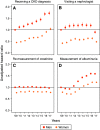Sex Differences in the Recognition, Monitoring, and Management of CKD in Health Care: An Observational Cohort Study
- PMID: 35906075
- PMCID: PMC9528319
- DOI: 10.1681/ASN.2022030373
Sex Differences in the Recognition, Monitoring, and Management of CKD in Health Care: An Observational Cohort Study
Abstract
Introduction: Reported sex differences in the etiology, population prevalence, progression rates, and health outcomes of people with CKD may be explained by differences in health care.
Methods: We evaluated sex as the variable of interest in a health care-based study of adults (n=227,847) with at least one outpatient eGFR<60 ml/min per 1.73 m2 measurement denoting probable CKD in Stockholm from 2009 to 2017. We calculated the odds ratios for diagnosis of CKD and provision of RASi and statins at inclusion, and hazard ratios for CKD diagnosis, visiting a nephrologist, or monitoring creatinine and albuminuria during follow-up.
Results: We identified 227,847 subjects, of whom 126,289 were women (55%). At inclusion, women had lower odds of having received a diagnostic code for CKD and were less likely to have received RASi and statins, despite having guideline-recommended indications. In time-to-event analyses, women were less likely to have received a CKD diagnosis (HR, 0.43; 95% CI, 0.42 to 0.45) and visited a nephrologist (HR, 0.46; 95% CI, 0.43 to 0.48) regardless of disease severity, presence of albuminuria, or criteria for referral. Women were also less likely to undergo monitoring of creatinine or albuminuria, including those with diabetes or hypertension. These differences remained after adjustment for comorbidities, albuminuria, and highest educational achievement, and among subjects with confirmed CKD at retesting. Although in absolute terms all nephrology-care indicators gradually improved over time, the observed sex gap persisted.
Conclusions: There were profound sex differences in the detection, recognition, monitoring, referrals, and management of CKD. The disparity was also observed in people at high risk and among those who had guideline-recommended indications.
Podcast: This article contains a podcast at https://www.asn-online.org/media/podcast/JASN/2022_10_11_JASN2022030373.mp3.
Keywords: chronic kidney disease; epidemiology and outcomes; sex difference.
Copyright © 2022 by the American Society of Nephrology.
Figures


Comment in
-
Sex Disparities in the Quality of Care for CKD.J Am Soc Nephrol. 2022 Oct;33(10):1804-1806. doi: 10.1681/ASN.2022080939. Epub 2022 Sep 12. J Am Soc Nephrol. 2022. PMID: 36096636 Free PMC article. No abstract available.
References
-
- Kidney Disease : Improving Global Outcomes (KDIGO) CKD Work Group. KDIGO 2012 clinical practice guideline for the evaluation and management of chronic kidney disease. Available at: https://kdigo.org/guidelines/ckd-evaluation-and-management/. Accessed January 23, 2021
-
- Park JI, Baek H, Jung HH: CKD and health-related quality of life: The Korea national health and nutrition examination survey. Am J Kidney Dis 67: 851–860, 2016 - PubMed
-
- Legrand K, Speyer E, Stengel B, Frimat L, Ngueyon Sime W, Massy ZA, et al. : Perceived health and quality of life in patients with CKD, including those with kidney failure: Findings from national surveys in France. Am J Kidney Dis 75: 868–878, 2020 - PubMed
-
- Jameson K, Jick S, Hagberg KW, Ambegaonkar B, Giles A, O’Donoghue D: Prevalence and management of chronic kidney disease in primary care patients in the UK. Int J Clin Pract 68: 1110–1121, 2014 - PubMed
Publication types
MeSH terms
Substances
Grants and funding
LinkOut - more resources
Full Text Sources
Medical
Research Materials
Miscellaneous

